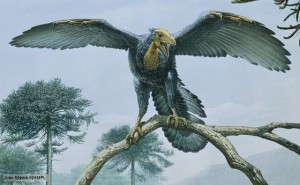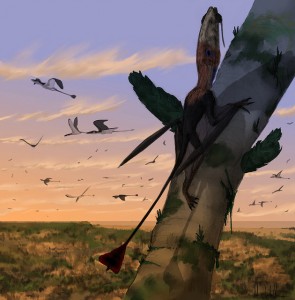Birds are a phenomenal story of evolutionary success. As modern-day dinosaur descendants, they occupy almost all environments and ecosystems around the globe, and are truly animals that capture our imaginations. However, how did they become so diverse, both in number and form? This is something only the fossil record can divine for us.
Birds first appear in the Middle to Late Jurassic of China and latest Jurassic of Europe (hello, Archaeopteryx), around 160-150 million years ago. Their first radiation, in terms of increasing species numbers, appears to have occurred in the Early Cretaceous of China, based on the fossil graveyards of the 125 million year old Jehol Biota. However, it has been argued that the timing of this radiation is strongly influenced by ‘the Lagersttäten effect’ – that is, periods of exceptional preservation in the fossil record. For the early evolution of birds, this is complicated by the fact that the earliest Cretaceous (around 145 to 125 million years ago) fossil record of birds is known from only rare and fragmentary material.

One of the earliest known birds, Archaeopteryx, from the infamous Solnhofen beds of Bavaria, Germany. (source)
At some time around then, however, it is though that birds underwent a phase of rapid diversification of body forms, particularly geared towards increasingly small body sizes. This has important implications for the evolution of flight, but that’s another story.
A possible trigger for this diversification might have been with an extinction event at the end of the Jurassic, 145 million years ago, which saw the decimation of smaller-sized pterosaurs (their non-dinosaurian, winged cousins), particularly those known as rhamphorhynchids. Ecologically speaking, this would have opened up ‘ecospace’, for other animals to radiate into and occupy. Animals, such as birds.
What you would expect to see if this is the case, is increasing diversity of birds, which we do see, as well as increasing diversity of their body forms, their morphology, and ecological variants.

Were pterosaurs duking it out against birds for millions of years? (source)
However, is this what we the fossils record for us? A recent study has shown that, despite the high diversity represented by the Jehol Biota, we actually see constrained levels of morphological diversity – known as disparity.
Much of the Jehol bird fauna seems to have been comprised of ground foragers, which is curious as they would all have been flight capable. Interestingly, this seems to be at odds with the local pterosaur fauna. These chaps were still owning the skies, and diversifying into an increasingly bizarre suite of forms.
Could it be, perhaps, that there was a sort of ‘fight for the skies’ happening at this time? Perhaps while both pterosaurs and birds radiating, they were competing to constrain the extent to which the others could evolve, and restricted them to particular ecologies. This hypothesis is certainly appealing, and tells of a sort of ‘fight for the skies’ in the early origin of birds.
Understanding why this was happening, and which roles birds were most successful in, is important for understanding their survival through the end-Cretaceous mass extinction and the demise of non-avian dinosaurs, as well as their rise to fame in modern times.
Reference
Mitchell, J. S. and Makovicky, P. J. (2014) Low ecological disparity in Early Cretaceous birds, Proceedings of the Royal Society, Series B: Biological Sciences, 281, 20140608. (link)

Sam Barnett
Interesting piece. I often wonder why it is that gulls and crows, though occupying near-identical scavenging niches, never truly drive each other out. Where there’s one, you usually find the other. Worldwide the species change but these two remain. Maybe the corvids do better at problem solving their way to a carcass while the gulls do better at eating quickly before anything else gets in there. Differences in approach to the same environmental role leading to both groups’ continued success. If two birds can crack the same nut in different ways, how much more different would the pterosaur vs early bird approaches be?
Jon Tennant
Well, there’s the next step then right! Create an ecomorphotype through time plot for both, and see where they’re similar and where they’re different.. Easy, right? 😉
Bill Montante
Sam and Tim : In systems thinking parlance what you might be describing is a “Success to the Successful” (google it if not familiar) dynamic played out over time; an out-competing, or out thinking of the competition for available limited resources using novel approaches…..what complex adaptive systems do , naturally…….
Paolo
Aerial, terrestrial and aquatic locomotion are all adaptive and each offers constraints on other types of locomotion. Birds would most likely hold an advantage over pterosaurs on the ground, given the locomotor modules inherited from dinosaurian ancestors, so it would make sense for the niche to be segregated in this manner. When you look at modern taxa you see similar patterns of niche segregation, with niche selection being driven by competition – which is part of the reason why you can get terrestrial bats species like Mystacina tuberculata in regions that lack nocturnal terrestrial mammals, but not in places where the niche is already more effectively filled.
In terms of Sam’s observations on gulls and crows, they have overlapping niches, but again they have different locomotor adaptations. Both are good in the air, but gulls can utilise the water surface, whereas the crows can better utilise terrestrial habitats. The main times they are brought into competition are when they in littoral or riparian areas where neither has a clear advantage, but both have adaptations that help mediate their foraging success.
Pingback: Morsels For The Mind – 27/02/2015 › Six Incredible Things Before Breakfast